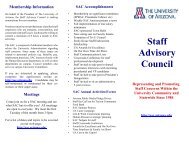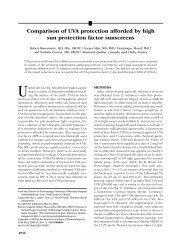Flood Trends and Global Change Summary I) Introduction
Flood Trends and Global Change Summary I) Introduction
Flood Trends and Global Change Summary I) Introduction
You also want an ePaper? Increase the reach of your titles
YUMPU automatically turns print PDFs into web optimized ePapers that Google loves.
<strong>Summary</strong><br />
<strong>Flood</strong> <strong>Trends</strong> <strong>and</strong> <strong>Global</strong> <strong>Change</strong><br />
Thomas Loster<br />
Geoscience Research Group<br />
Munich Reinsurance Company<br />
The great floods that affected the Mississippi (USA 1993), China (1996, 1998), India, Nepal<br />
<strong>and</strong> Bangladesh (1998) attracted great attention throughout the world. In Europe too a noticeable<br />
accumulation <strong>and</strong> an increase in extreme events created a stir. The floods on the Rhine<br />
<strong>and</strong> its tributaries (Germany 1993, 1995), in eastern Germany (1994), in Italy (1993) <strong>and</strong> on<br />
the Odra (Pol<strong>and</strong>, Czech Republic 1997) are just a few examples of exceptional floods. The<br />
analysis of worldwide loss events shows that there are distinct increases in respect of the economic<br />
losses, developments in term of the number of events represent no or only a moderate<br />
trend. Loss amounts have risen all over the world, with enormous increases in economic<br />
losses even in less developed countries. Insured losses have increased even more distinctly on<br />
account of the fact that the majority of the world’s markets offered virtually no cover against<br />
flood losses in the 1950s <strong>and</strong> 1960s. In the following, the causes of loss <strong>and</strong> the potential future<br />
developments will be discussed.<br />
Synopsis: <strong>Flood</strong> catastrophes are becoming more frequent <strong>and</strong> more intensive. If global<br />
warming takes place as predicted, a further dramatic deterioration in the risk situation must be<br />
expected.<br />
I) <strong>Introduction</strong><br />
Worldwide, flooding is the leading cause of losses from natural hazards <strong>and</strong> is responsible for<br />
a greater number of damaging events than any other type of natural event. At least one third<br />
of all losses due to nature’s forces can be attributed to flooding. <strong>Flood</strong> damage has been extremely<br />
severe in recent decades <strong>and</strong> it is evident that both the frequency <strong>and</strong> intensity of<br />
floods are increasing. In the past ten years losses amounting to more than 250 billion dollars<br />
have had to be born by societies all over the world to compensate for the consequences of<br />
floods. There are countries, such as China, in which flooding is a frequent, at least annual<br />
event, <strong>and</strong> others, such as Saudi Arabia, where inundation is rare, but its impact is sometimes<br />
also severe. No populated area in the world is safe from being flooded. However, the range of<br />
vulnerability to the flood hazard is very wide, in fact wider than for most other hazards. Some<br />
societies (communities, states, regions) have learnt to live with floods. They are prepared.<br />
Others are sometimes taken completely by surprise when a river stage (or the sea) rises to a<br />
level residents have never experienced in their lifetime. Three aspects are very important in<br />
this context: (1) the dramatic increase in the population of the world <strong>and</strong> some regions, which<br />
creates the necessity to settle in areas that are dangerous; (2) the movement of refugees (political,<br />
social <strong>and</strong> other) to environments with which they are not familiar; (3) the increased<br />
mobility <strong>and</strong> the desire of people to live in areas that have a beautiful natural environment <strong>and</strong><br />
a certain climate. All these factors bring people into areas whose natural features they do not<br />
know. They are not aware of what can happen <strong>and</strong> they have no idea how to behave if nature<br />
strikes. This is one of the underlying reasons why natural catastrophes are becoming more <strong>and</strong><br />
more frequent <strong>and</strong> severe.<br />
In the past (more than 50 years ago), floods were responsible for a huge number of deaths.<br />
With the exception of storm surges this is not so anymore today. The table of the deadliest<br />
disasters during the past 30 years contains only two water-related great disasters, the 1970 <strong>and</strong><br />
1
1991 Bangladesh storm surges, which rank first <strong>and</strong> third respectively. For no other type of<br />
natural disaster have early warning methods become more operational, more reliable <strong>and</strong><br />
hence more effective than for meteorological <strong>and</strong> hydrological disasters. A 1994 Bangladesh<br />
storm surge that ran up to a height comparable to the one in 1991 cost the lives of only 200<br />
people. This reduction in the number of victims has mainly been a consequence of improved<br />
early warning methods based on better storm forecast models together with the availability of<br />
elevated shelters that allowed people on low l<strong>and</strong> to flee the flood waters. Nowadays geological<br />
disasters (earthquakes, volcanic eruptions, l<strong>and</strong>slides) pose the deadliest threat. In addition<br />
to their extremely sudden onset, the prediction of major geological events is difficult or even<br />
impossible, <strong>and</strong> in most cases there is no time left for warning. Exceptions are perhaps wellobserved<br />
<strong>and</strong> well-instrumented volcanoes; predicting their eruptions is quite feasible. Hydrological<br />
events almost always build up relatively slowly. Even the few minutes an approaching<br />
flash flood allows to leave the scene may be enough for many people to save their<br />
lives while the surprising strike of an earthquake leaves many dead or injured.<br />
If we look at the losses, we see a different picture. Economically, floods are the number one<br />
cause of losses from natural events. Not only “Great Disasters” display such a tendency, but<br />
also the total annual amount of losses from the many small <strong>and</strong> medium-sized events. On average,<br />
floods cause more damage than any other destructive natural event. Additionally, one<br />
should bear in mind that the financial means societies all over the world spend on flood control<br />
(dikes, reservoirs, etc.) is a multiple of the costs they devote to protection against other<br />
impacts from nature.<br />
As far as insured losses are concerned, windstorm in all its various forms, dominates the statistics.<br />
Among the top nine insurance catastrophes, seven belong to the category of windstorm.<br />
In a list ordered by insurance losses, the costliest flood ever incurred by the insurance<br />
industry, the “Great <strong>Flood</strong> of 1993” along the Mississippi, <strong>and</strong> the China <strong>Flood</strong>s 1998 rank<br />
only 19, whereas the Odra flood of 1997 ranks somewhere in the thirties or forties. The reason<br />
for the shift from “<strong>Flood</strong>” to “Storm” is the much higher insurance density for the latter.<br />
A comparison of flood <strong>and</strong> all other natural hazards in long-term analyses (1988-1997) reveals<br />
the following features:<br />
- <strong>Flood</strong>s account for about a third of all natural catastrophes.<br />
- They cause more than half of all the fatalities due to natural catastrophes throughout the<br />
world.<br />
- They are responsible for a third of the overall economic loss.<br />
- Their share in insured losses is relatively small, with an average of just under 10 %, as<br />
cover for the flood risk is offered very conservatively in many markets or does not exist at<br />
all.<br />
The following tables present the largest events of the 1990s throughout the world, ordered by<br />
the number of fatalities, economic losses <strong>and</strong> insured losses.<br />
2
a) Deaths<br />
Table 1: Significant flood loss events 1990-1998*<br />
Rank/Date Country, region Total losses** Insured losses** Deaths<br />
1 10.6. - 30.9.1998 India, Bangl., Nepal 5,020 --/< 1 4,750<br />
2 May - Sep. 1998 China 30,000 1,000 3,656<br />
3 21.6. - 20.9.1993 China 11,000 --/< 1 3,300<br />
4 May - Sep. 1991 China 15,000 410 3,074<br />
5 27.6. - 13.8.1996 China 24,000 445 3,048<br />
6 Oct. - Dec. 1997 Somalia -- --/< 1 1,800<br />
7 4.9. - 2.10.1992 India 1,000 --/< 1 1,500<br />
* storm surges escluded © Munich Re 1999<br />
** US$ m (original values)<br />
b) Economic losses<br />
Rank/Date Country, region Total losses* Insured losses* Deaths<br />
1 May - Sep. 1998 China 30,000 1,000 3,656<br />
2 27.6. - 13.8.1996 China 24,000 445 3,048<br />
3 27.6. - 15.8.1993 USA, Mississippi 16,000 1,000 45<br />
4 24.7.-18.8.1995 North Korea 15,000 --/< 1 68<br />
5 May - Sep. 1991 China 15,000 410 3,074<br />
6 21.6. - 20.9.1993 China 11,000 --/< 1 3,300<br />
7 4.-6.11.1994 Italy, N 9,300 65 64<br />
* US$ m (original values) © Munich Re 1999<br />
c) Insured losses<br />
Rank/Date Country, region Total losses* Insured losses* Deaths<br />
1 27.6. - 15.8.1993 USA, Mississippi 16,0000 1,000 45<br />
2 May - Sep.1998 China 30,0000 1,000 3,656<br />
3 20. - 31.12.1993 Europe 2,000 800 14<br />
4 5.7. - 10.8.1997 Europe 5,900 785 110<br />
5 19.1. - 3.2.1995 Europe 3,500 750 28<br />
6 20. - 28.9.1993 Europe 1,500 500 16<br />
7 3. - 10.1.1995 USA 1,800 470 11<br />
*US$ m (original values) © Munich Re 1999<br />
3
number<br />
800<br />
700<br />
600<br />
500<br />
400<br />
300<br />
200<br />
100<br />
0<br />
A survey of the significant catastrophes (Tab. 1) shows that floods continue to cause the largest<br />
numbers of deaths in the poor <strong>and</strong> heavily populated countries of the world. In terms of<br />
economic losses, a regional distinction is hardly possible any more. Large loss amounts are<br />
mainly generated by the accumulation of values in the regions affected or exceptionally longlasting<br />
events <strong>and</strong> widespread flooded areas. The largest insured losses are encountered, as<br />
might be expected, in the industrial countries, where the insurance density is generally at its<br />
highest.<br />
II) <strong>Trends</strong>, statistics<br />
The following analysis involved an analysis of the flood catastrophes registered in Munich<br />
Re’s natural events database (NatCatSERVICE). For more than 25 years, data on natural loss<br />
events have been gathered from all over the world <strong>and</strong> entered in this database (property<br />
losses <strong>and</strong> bodily injury). Two different approaches were chosen. The first involved examining<br />
all the loss events we had recorded since 1987 (earthquake, windstorms, severe storms,<br />
floods, droughts, etc.), <strong>and</strong> the second focussed on great natural catastrophes since 1950. The<br />
advantage of this approach is obvious: an analysis of all the losses recorded might simply reveal<br />
an increase due to improved flows of information. The media revolution (global information<br />
networks, Internet, data highways, etc.) is a – possibly substantial – increase in the<br />
volume of information <strong>and</strong> hence in the dataset itself. Great natural catastrophes can be analysed<br />
very well in retrospect, because even records that go back several decades can still be<br />
investigated today. This means that a considerably longer period of time can be observed here<br />
too.<br />
Fig. 1: Development in the number of natural catastrophes globally <strong>and</strong> in Europe<br />
1987 – 1998<br />
Others<br />
Earthquake<br />
Storm<br />
<strong>Flood</strong><br />
© Munich Re 1999<br />
World<br />
1987 1988 1989 1990 1991 1992 1993 1994 1995 1996 1997 1998<br />
year<br />
number<br />
Europe<br />
Earthquake<br />
160<br />
Storm<br />
140 <strong>Flood</strong><br />
120<br />
100<br />
80<br />
60<br />
40<br />
20<br />
0<br />
1987 1988 1989 1990 1991 1992 1993 1994 1995 1996 1997 1998<br />
year<br />
Every year between 550 <strong>and</strong> 700 events are recorded. If we look at the number of events over<br />
the past twelve years (for which there are verified data, whereas the records for previous years<br />
are incomplete), we will see that as far as the number of events is concerned there are no significant<br />
trends either globally or in Europe. The number of flood catastrophes varies from<br />
year to year <strong>and</strong> exhibits no trends whatsoever. If we take all natural hazards together, we will<br />
see a slight development upwards. This may be attributed to the above-mentioned increase in<br />
the flow of information <strong>and</strong> should therefore not be taken too seriously. These observations do<br />
not apply to loss amounts, however, which have increased significantly in the past years <strong>and</strong><br />
decades.<br />
Others<br />
4
Table 2: Great <strong>Flood</strong> Disasters* 1950 – 1998<br />
Decade comparison<br />
Decade Decade Decade Decade last 10 Factor Factor<br />
1950-59 1960-69 1970-79 1980-89 1989-98 last 10:50 last 10:60<br />
Number 7 7 9 20 34 4.9 4.9<br />
Economic losses 27.9 20.2 19.2 25.5 199.6 7.2 9.9<br />
Insured losses --- 0.2 0.4 1.4 7.4 --- 37<br />
Losses in bn US-$ - values 1998 © Munich Re 1999<br />
* In this context, floods are classed as great if the ability of the region to help itself is distinctly overtaxed,<br />
making interregional or international assistance necessary. This is usually the case when thous<strong>and</strong>s of people<br />
are killed, hundreds of thous<strong>and</strong>s are made homeless, or when a country suffers substantial economic losses<br />
(depending on the economic circumstances generally prevailing in that country).<br />
If we compare the individual decades, we will see that economic losses of the last ten years<br />
are ten times as high as in the 1950s – after adjusting for inflation. The number of losses has<br />
also increased (by a factor of 5). As far as insured losses are concerned, flood insurance was<br />
still in the early stages of development in the 1950s, so that a factor can only be given for the<br />
1960s (37-fold increase). In the future the long-term global trend towards multiple risks cover,<br />
which will often include flood losses, will push the figures up even more distinctly.<br />
III) Causes<br />
The reasons for the increase in catastrophes have been dealt with in numerous essays <strong>and</strong> will<br />
be presented exhaustively by other speakers during this conference. At this point then, I will<br />
just list these reasons more or less without comment.<br />
1. population developments globally <strong>and</strong> in exposed regions<br />
2. the increase in values in these regions<br />
3. the increase in the vulnerability of structures (infrastructure, building structures)<br />
<strong>and</strong> of goods (stock, furnishings, etc.)<br />
4. construction in flood-prone areas<br />
5. often immoderate trust in flood protection systems<br />
6. changes in environmental conditions.<br />
The last mentioned natural factors (precipitation, changes in river courses <strong>and</strong> catchment areas,<br />
etc.) play a decisive role <strong>and</strong> have worsened the situation in many cases <strong>and</strong> have led to<br />
an intensification of the catastrophes. As a rule, however, they cannot be classed as the main<br />
reason. The sometimes extreme hydro-meteorological circumstances encountered in great<br />
floods usually fall within the range of natural variability <strong>and</strong> can only partially be linked with<br />
the emerging climate change. Some features appear to fit very well into the picture of a<br />
"warmer" climate (e.g. rainy <strong>and</strong> possibly mild winters in central Europe), but climate change<br />
cannot be made the scapegoat for all the events of recent years. Nevertheless it will certainly<br />
have a regional effect on the flood risk (see below).<br />
5
Table 3: Exceptional floods – special hydro-meteorological features<br />
(selected examples)<br />
Event Precipitation (hydro-meteorological features)<br />
Mississippi 1993: widespread precipitation, 100 rivers (9 states) affected<br />
Rhine (D) 1993: winter with little snow, extended (damp) weather situation (Wz)<br />
Red River 1997: extreme snow volume/snow melt (500-year flood)<br />
Odra (Cz, Pl)1997: Vb track with exceptional rainfall twice in close succession<br />
East Africa 1997/98 Kenya: 105 mm/24h, Somalia: 200 mm/24h (El Niño)<br />
China 1998: large area/precipitation/duration, 7 – 8 floods waves in the Yangtze<br />
Belgium 1998: 143 mm of rain in 12 hours. Highest prec. in 130 years<br />
IV) Prospects<br />
A cautious look into the future shows that as far as flood events <strong>and</strong> catastrophes are concerned<br />
there are hardly any positive developments to be expected. The decisive factors are:<br />
ΠPopulation growth<br />
Population growth will persist. The development in exposed regions will continue to play<br />
a major role in terms of flood. Today, more than half of the people live within 60 km of<br />
the coast; 65 % of cities with more than 2.5m inhabitants are directly on the coast. And<br />
migration will continue.<br />
There are three main reasons:<br />
. In some countries the pressure of population growth is increasing <strong>and</strong> there is no<br />
choice but to retreat to exposed areas. Bangladesh, where hundreds of people are<br />
killed in floods almost every year, is a perfect example.<br />
. In other countries, like the United States, access to the coast is increasing for other<br />
reasons, such as aesthetic factors or climatic preference. By the year 2010, for example,<br />
about 30% of all US Americans will be living within 10 miles of the coast – according<br />
to figures published by the ministry of economics.<br />
. The urbanization of the earth is continuing unabated. The number of cities with a<br />
population of at least one million has increased more than four-fold in the last 48 years<br />
(1950/1998:83/369), with numerous megacities being created. Here in particular, the<br />
areas where the poorest of the poor live are hit time <strong>and</strong> again by severe flood <strong>and</strong><br />
l<strong>and</strong>slide catastrophes (e.g. Caracas, Manila, Sao Paulo) because of the lack of precautionary<br />
measures.<br />
- L<strong>and</strong> use<br />
As far as the flood hazard is concerned, there does not appear to be any return to reason in<br />
terms of l<strong>and</strong> use. This applies just as much to those affected, who seldom move out of<br />
exposed areas even after a loss event has occurred, as it does to the political powers, who<br />
are unprepared or hesitant when it comes to l<strong>and</strong> use recommendations or restrictions. Industrial<br />
<strong>and</strong> residential areas are located behind supposedly safe dikes in flood-prone areas,<br />
where the trust placed in the area's safety allows the concentrations of values to rise.<br />
- Insurance<br />
The insurance density is increasing all over the world – rapidly in some countries, slowly<br />
in others. The insurance of floods presents a particular challenge. In many countries the<br />
6
principle of solidarity does not function because the transfer of losses from those affected<br />
to the community at large is not feasible at a realistic premium. In many markets insurance<br />
is prevented from functioning by antiselection. Nevertheless, there is a trend towards<br />
multiple-risk <strong>and</strong> all-risk covers particularly in the industrial countries. <strong>Flood</strong> insurance<br />
exerts an indirect influence on the state’s obligations (protection of its citizens <strong>and</strong> their<br />
resources etc.). The question is whether flood protection <strong>and</strong> l<strong>and</strong> use can be channelled in<br />
the right way if the public, industry <strong>and</strong> commerce are fully insured. An improvement – in<br />
the direction of fewer losses – is only possible if insurers can impose conditions in the<br />
form of requiring preventive measures. The incorporation of a substantial deductible in the<br />
insurance terms <strong>and</strong> conditions is the best precautionary measure of all. But the opportunities<br />
open to insurers are limited on account on the competitive situation. It is only when<br />
the loss burden explodes that the companies in the affected market react with the introduction<br />
of deductibles.<br />
- Climate change<br />
Besides the rise in sea levels forecast for the coming century by the Intergovernmental<br />
Panel on Climate <strong>Change</strong> (IPCC), an increase in humidity levels as a result of higher rates<br />
of evaporation will have a particularly grave effect as it will have a decisive influence on<br />
all precipitation <strong>and</strong> convection process in the troposphere. Generally speaking, an increase<br />
is to be expected in torrential rainfall at regional level. That has already been confirmed<br />
by an initial analysis of measurements in Europe <strong>and</strong> America. There is also firm<br />
evidence of shifts in the seasons, e.g. in Germany (drier summers, wetter winters). In<br />
Europe, milder winters, which are likely to occur in a warmer climate, can also have a<br />
grave effect on the flood risk. They lead to an increase in the natural sealing during the<br />
winter months as a result of precipitation in predominantly liquid form. Winter storms <strong>and</strong><br />
low-pressure systems combined with copious precipitation produce surface run-off, which<br />
soon results in flood waves. It is also conceivable that storms with torrential rain will<br />
penetrate further into the continent of Europe. The lack of snow results in a loss of the<br />
blocking effect of the cold high-pressure system over eastern Europe, so that winter<br />
storms are no longer diverted <strong>and</strong> can penetrate far into the continent, as in 1990 during<br />
the unprecedented series of storms between 25th January <strong>and</strong> 1st March 1990 in central<br />
Europe (eight destructive storms in close succession). The storm surge risk will also increase<br />
on many coasts of the earth if the IPCC's forecasts are confirmed, as rising sea levels<br />
in concert with an increase in the circulation of the atmosphere will increase the number<br />
of storm surges.<br />
To sum up we may say that we must reckon with more – <strong>and</strong> larger – flood events <strong>and</strong> catastrophes<br />
in the future. For this reason it is important to take appropriate steps without delay.<br />
On the one h<strong>and</strong>, the efforts that are being taken to combat climate change must be stepped<br />
up, while on the other h<strong>and</strong> we must pay more attention to flood protection <strong>and</strong> loss minimization<br />
or prevention in the ways described above. Technical, organizational <strong>and</strong> financial<br />
measures designed to reduce the flood hazard are well-known in large numbers, <strong>and</strong> many are<br />
available. Long-term <strong>and</strong> short-term precautions play just as large a part in this as catastrophe<br />
aid <strong>and</strong> post-event measures. One thing is certain, however: flood is a subject that involves<br />
everyone, which means that everyone has to work together in combating it. Authorities, scientists<br />
<strong>and</strong> the insurance industry have clearly defined briefs. The insurance industry <strong>and</strong> the<br />
world of science must join together in formulating their requirements <strong>and</strong> prepare them in<br />
such a way that the political powers can derive clearly recognizable policy options (e.g. l<strong>and</strong><br />
use restrictions) from them.<br />
7








